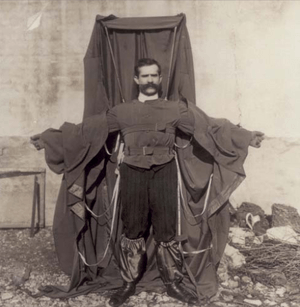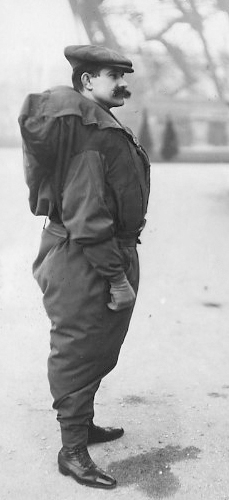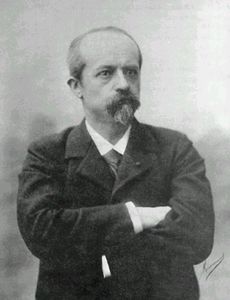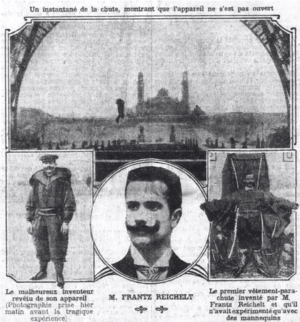Franz Reichelt facts for kids
Quick facts for kids
Franz Reichelt
|
|
|---|---|

Franz Reichelt wearing his parachute suit
|
|
| Born | 16 October 1878 Wegstädtl, Kingdom of Bohemia, Austria-Hungary
|
| Died | 4 February 1912 (aged 33) |
| Cause of death | Parachute failure |
| Occupation |
|
Franz Reichelt (born October 16, 1878 – died February 4, 1912) was a French tailor and inventor. He was born in the Austro-Hungarian Empire. People sometimes called him the Flying Tailor. He is known for a tragic event: he jumped to his death from the Eiffel Tower. He was testing a special parachute suit he had designed himself.
Reichelt was very keen on creating a suit for aviators (early pilots). This suit would turn into a parachute. It would help them survive if they had to jump from their aircraft. He first tried dropping dummies from his apartment building. These early tests seemed to work. But he could not make his later designs work as well.
Reichelt believed his invention needed a very high place to be tested. He asked the police in Paris many times for permission. He wanted to test his suit from the Eiffel Tower. In 1912, he finally got permission. But when he arrived at the tower on February 4, he said he would jump himself. He did not want to use a dummy. People tried to stop him. But he jumped from the first level of the tower. His parachute did not open. He fell 57 meters (about 187 feet) and died. The next day, newspapers showed many pictures and stories about the "reckless inventor." News channels also showed videos of his jump.
Early Life
Franz Reichelt was born in 1878 in a town called Wegstädtl. This town was in what is now the Czech Republic. He moved to Paris, France, in 1898. In 1909, he became a French citizen. He changed his first name to François, which is the French version of Franz. He lived in an apartment in Paris and ran a successful dressmaking business. Many of his customers were from Austria.
Experiments with Parachutes

Starting in July 1910, Reichelt began working on his "parachute-suit." He wanted it to be like a normal pilot's suit. But it would have hidden rods, a silk canopy, and rubber. These parts would let it open up into a parachute. He hoped it would be a useful and safe parachute.
At that time, airplanes were new. Accidents happened often. So, people were very interested in making flying safer. They especially wanted a good parachute. Some people had already made successful parachute jumps. For example, Louis-Sébastien Lenormand jumped in 1783. And Jean-Pierre Blanchard used parachutes from balloons. These parachutes were already open before the jump. André-Jacques Garnerin also invented a parachute for high altitudes. But by 1910, there was still no good parachute for jumping from a plane or from low heights.
Reichelt became interested in parachutes after hearing about fatal accidents. These accidents involved early pilots and balloonists. His first tests seemed promising. He dropped dummies with silk "wings" from his fifth-floor apartment. They landed softly. But it was hard to turn these ideas into a suit that a person could wear. His first design used 6 square meters (about 65 sq ft) of material. It weighed around 70 kilograms (about 154 pounds).
He showed his design to a big aviation group called La Ligue Aérienne. He hoped they would test it. But they said his design was too weak. They told him not to spend more time on it. Reichelt did not give up. He kept doing tests with dummies in his building's courtyard. None of these tests worked well.
In 1911, a man named Colonel Lalance offered a prize. It was 10,000 francs for a safety parachute for pilots. The parachute had to weigh no more than 25 kilograms (about 55 pounds). Reichelt made his design lighter. He also made the material's surface area bigger, up to 12 square meters (about 129 sq ft). But his tests still failed. His dummies always fell hard to the ground. Some newspapers reported that he even jumped himself from 8 to 10 meters (about 26 to 33 feet) high. One attempt caused a broken leg. Reichelt thought his designs failed because he tested them from low heights. So, he really wanted to test his invention from the Eiffel Tower.
The Eiffel Tower Jump
In early February 1912, Reichelt told the newspapers he had permission. He would soon test his invention from the Eiffel Tower. He wanted to prove it worked.
On Sunday, February 4, at 7:00 a.m., he arrived at the tower. He was with two friends. He was already wearing his parachute suit. News videos show him wearing the suit. It looked only a little bigger than normal clothes. The suit did not stop him from moving when it was folded. To open the parachute, he just had to spread his arms like a cross. Once open, it looked like a "cloak with a very large silk hood." The final design had a surface area of about 30 to 32 square meters (about 323 to 344 sq ft). The weather was cold, below 0°C (32°F). There was also a strong wind.
Some police officers were there to keep order. The police chief had given Reichelt permission. But after Reichelt's death, the police chief said something important. He said the police usually gave permission for tests from the Eiffel Tower only for dummies. He said they would never have allowed Reichelt to jump himself. He had only approved a dummy test. But when Reichelt arrived, he made it clear he would jump. One of his friends later said Reichelt had kept his plan a secret until the last minute.
His friends tried to convince him to use dummies. They said he would have other chances to jump later. When that didn't work, they pointed out the strong wind. They told him to cancel or delay the test. But Reichelt was determined. He told reporters he was sure his invention would work well. When asked if he would use a safety rope, he said no. He wanted to trust his life completely to his parachute. He said: "I want to try the experiment myself and without trickery, as I intend to prove the worth of my invention."
Another inventor, Gaston Hervieu, was there. He also tried to stop Reichelt. He worried the parachute needed more time to open than the short fall from the first platform allowed. Reichelt replied: "You are going to see how my seventy-two kilos and my parachute will give your arguments the most decisive of denials."
The police had put ropes around the landing area. This was to keep the crowd back. Reichelt talked with the marshals. He made sure there was enough space for his landing. Then he went to the stairs to climb the tower.
A guard tried to stop Reichelt from going up. The guard had seen his failed dummy drops before. He feared a disaster. But the issue was resolved. By 8:00 a.m., Reichelt was allowed to go up. He went with his two friends and a cameraman. Another cameraman was at the bottom of the tower. As he climbed, Reichelt turned to the crowd. He raised his hand and said, "See you soon." His friends kept trying to talk him out of it. But Reichelt was set on jumping.
At 8:22 a.m., about 30 journalists and onlookers watched. Reichelt stood on a stool on a table. This was next to the railing of the tower's first level. It was about 57 meters (187 feet) above the ground. He adjusted his suit with his friends' help. He checked the wind by throwing a piece of paper. Then he put one foot on the guardrail. He paused for about 40 seconds. Then he jumped outwards. He was calm and smiling just before he jumped. His parachute seemed only half-open. It folded around him almost right away. He fell for a few seconds. Then he hit the frozen ground at the base of the tower.
His right leg and arm were crushed. His skull and spine were broken. He was bleeding from his mouth, nose, and ears. His eyes were wide open. He was already dead when people rushed to him. He was taken to a hospital, where he was officially pronounced dead.
Aftermath
The next day, newspapers were full of stories about Reichelt's "tragic experiment." Many newspapers showed pictures of the fatal jump. Videos of the event were also shared. These videos showed Reichelt's body being removed. They also showed people measuring the hole his impact made (15 centimeters, or about 6 inches deep).
At first, people wondered about Reichelt's state of mind. Many called him reckless or foolish. One journalist suggested that only half of "mad genius" fit Reichelt. But a friend of Reichelt said the tailor felt pressured. He needed to do a big demonstration to get sponsors. Without them, he couldn't make money from his invention.
Reichelt's death was the first from a parachuting accident since 1889. After his death, officials were careful about allowing parachute tests from the Eiffel Tower. They still allowed dummy drops. But they refused permission for live jumps. Even other aviation experiments were looked at more closely.
More recently, people have made illegal base jumps from the tower. In 2005, a man died after his parachute failed during a jump. This was the first parachuting death at the tower since Reichelt. However, a stunt jump for the 1985 James Bond film A View to a Kill was successful.
Reichelt's story was also made into a French short film in 1993. It was called Le Tailleur Autrichien (The Austrian Tailor).
Even though Reichelt's suit failed, other inventors were working on parachutes. For example, Gleb Kotelnikov had already applied for a patent for a parachute that could be packed.
See also
 In Spanish: Franz Reichelt para niños
In Spanish: Franz Reichelt para niños
- List of unusual deaths
- List of inventors killed by their own inventions
- Wingsuit flying
- Robert Emmet Odlum




